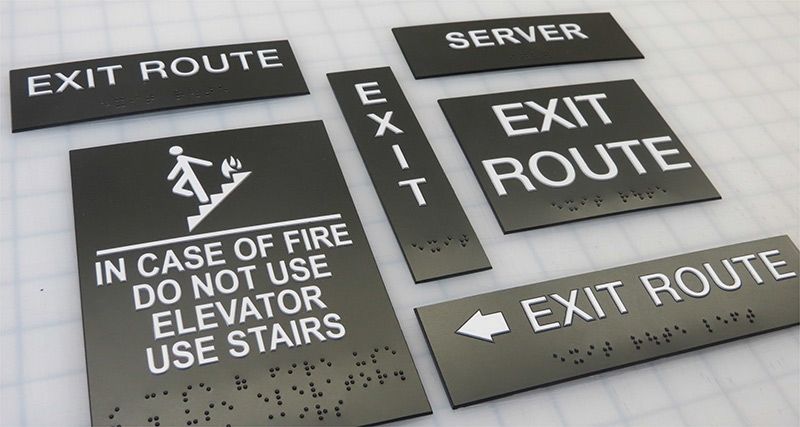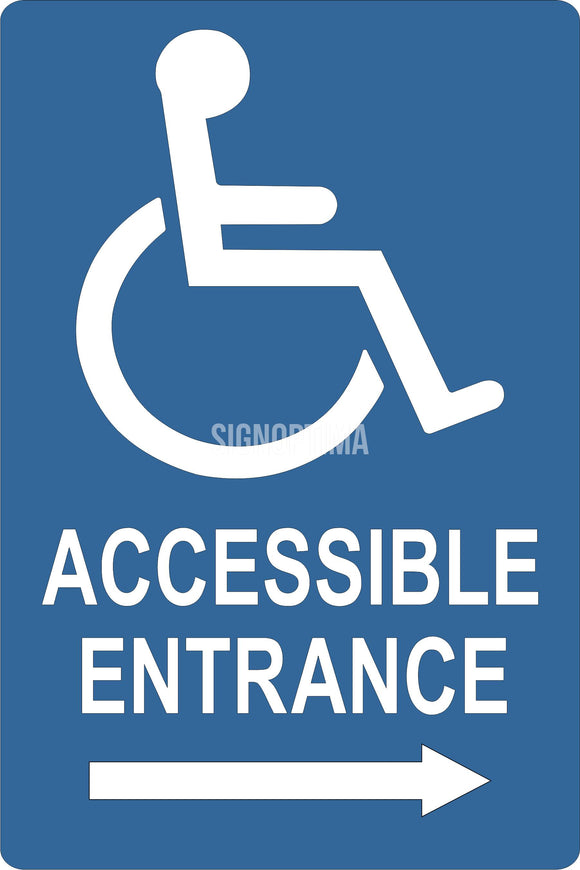Discovering the Secret Features of ADA Signs for Boosted Availability
In the realm of accessibility, ADA indicators serve as silent yet effective allies, guaranteeing that spaces are navigable and comprehensive for people with disabilities. By integrating Braille and responsive components, these signs damage obstacles for the visually damaged, while high-contrast shade systems and legible typefaces cater to varied visual needs.
Value of ADA Conformity
Ensuring compliance with the Americans with Disabilities Act (ADA) is vital for cultivating inclusivity and equivalent gain access to in public spaces and offices. The ADA, enacted in 1990, mandates that all public facilities, companies, and transportation solutions accommodate people with specials needs, guaranteeing they enjoy the same legal rights and opportunities as others. Conformity with ADA criteria not just meets lawful obligations but likewise improves an organization's track record by showing its dedication to variety and inclusivity.
Among the vital facets of ADA conformity is the execution of accessible signs. ADA signs are designed to ensure that individuals with disabilities can easily navigate via structures and rooms. These indications need to stick to certain standards relating to size, font, color comparison, and positioning to assure exposure and readability for all. Appropriately carried out ADA signage helps eliminate obstacles that individuals with handicaps often come across, consequently promoting their self-reliance and self-confidence (ADA Signs).
Additionally, adhering to ADA laws can alleviate the risk of potential penalties and legal effects. Organizations that stop working to abide by ADA standards might deal with suits or fines, which can be both economically burdensome and destructive to their public image. Hence, ADA compliance is indispensable to promoting a fair atmosphere for every person.
Braille and Tactile Components
The incorporation of Braille and responsive elements right into ADA signs personifies the concepts of ease of access and inclusivity. These features are important for individuals who are aesthetically damaged or blind, allowing them to navigate public areas with better independence and confidence. Braille, a tactile writing system, is crucial in giving written details in a layout that can be quickly perceived with touch. It is generally put beneath the equivalent message on signs to make sure that individuals can access the information without visual aid.
Responsive components expand past Braille and include raised symbols and personalities. These parts are made to be noticeable by touch, enabling individuals to identify area numbers, toilets, leaves, and various other essential locations. The ADA establishes details standards pertaining to the dimension, spacing, and placement of these tactile elements to optimize readability and ensure consistency across different atmospheres.

High-Contrast Color Design
High-contrast shade schemes play a critical duty in boosting the exposure and readability of ADA signs for individuals with aesthetic disabilities. These schemes are crucial as they make best use of the difference in light reflectance in between text and history, guaranteeing that indicators are quickly noticeable, also from a distance. The Americans with Disabilities Act (ADA) mandates making use of particular shade contrasts to accommodate those with minimal vision, making it an essential facet of compliance.
The effectiveness of high-contrast colors lies in their capacity to stand apart in numerous lighting conditions, consisting of poorly lit atmospheres and locations with glow. Usually, dark message on a light look here background or light text on a dark history is used to achieve ideal comparison. Black message on a white or yellow background supplies a raw aesthetic difference that helps in quick acknowledgment and understanding.

Legible Fonts and Text Dimension
When thinking about the style of ADA signage, the selection of readable font styles and ideal text size can not be overstated. The Americans with Disabilities Act (ADA) mandates that typefaces must be sans-serif and not italic, oblique, manuscript, extremely attractive, or of uncommon form.
The dimension of the text also plays a crucial role in access. According to ADA guidelines, the minimal message elevation must be 5/8 inch, and it should raise proportionally with viewing distance. This is especially important in public areas where signage requirements to be read promptly and precisely. Uniformity in text size adds to a cohesive visual experience, helping individuals in browsing settings effectively.
Furthermore, spacing in between lines and letters is important to readability. Appropriate spacing avoids personalities from showing up crowded, boosting readability. By adhering to these criteria, developers look these up can substantially boost access, ensuring that signs offers its intended objective for all people, no matter their aesthetic abilities.
Effective Positioning Techniques
Strategic positioning of ADA signs is essential for maximizing ease of access and ensuring conformity with lawful requirements. ADA standards stipulate that indications need to be placed at a height between 48 to 60 inches from the ground to ensure they are within the line of view for both standing and seated people.
In addition, indications have to be placed nearby to the latch side of doors to permit easy recognition before access. Consistency in indicator placement throughout a center enhances predictability, minimizing confusion and enhancing total individual experience.

Conclusion
ADA signs play an important function in promoting ease of access by integrating features that address the needs of people with handicaps. These components jointly promote an inclusive environment, underscoring the relevance of ADA conformity in making sure equal access for all.
In the realm of access, ADA indicators offer as silent yet effective allies, making certain that rooms are comprehensive and accessible for individuals with disabilities. The ADA, established in 1990, mandates that all public centers, employers, and transport solutions accommodate people with specials needs, ensuring they enjoy the very same legal rights and opportunities as others. ADA Signs. ADA indicators are developed to ensure that people with impairments can easily browse with spaces and structures. ADA guidelines specify that indications should be installed at a height in between 48 to 60 inches from the ground to ensure they are within the line of view for both standing and seated individuals.ADA indicators play an important duty in promoting access by integrating attributes that deal with the demands of individuals with handicaps